 Welcome back to Science Saturday! This week, discover Pluto’s new moon thanks to Hubble, see the first ever close-up view of asteroid Vesta, learn how the space shuttles will become museum pieces, and explore Gale Crater with the next Mars rover! All this and more, plus our gadget of the week: bionic glasses!
Welcome back to Science Saturday! This week, discover Pluto’s new moon thanks to Hubble, see the first ever close-up view of asteroid Vesta, learn how the space shuttles will become museum pieces, and explore Gale Crater with the next Mars rover! All this and more, plus our gadget of the week: bionic glasses!
Hubble discovers new moon around Pluto
The not-a-planet-anymore Pluto now has four, count ’em, four moons orbiting it’s distant icy body. The Hubble Space Telescope pointed its lens toward Pluto recently, and made the discovery of the moon, currently known as P4, orbiting somewhere between the orbits of Nix and Hydra. P4 sizes up to a mere 8-21 miles (13-34 km) in diameter. Compare that to Charon, Pluto’s largest moon, at 648 miles (1,043 km). More than 3 billion miles (5 billion km) away and we’re discovering things as small as 8 miles in diameter. Just imagine what we’ll see when New Horizons arrives in a few years!
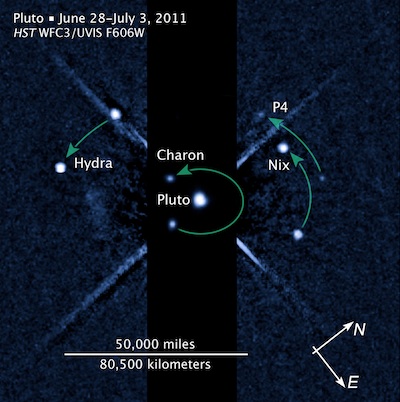
Pluto’s tiny new moon, P4, orbiting between Nix and Hydra
Dawn spacecraft 1st ever to orbit main asteroid, takes some photos
On Friday, July 15, Dawn became the first probe to enter orbit around an object in the main asteroid belt between Mars and Jupiter. The spacecraft has now returned the first ever close-up image of the giant asteroid Vesta. This is the most detailed view ever seen of the second most massive object in the asteroid belt. Earth and space telescopes have imaged Vesta before, but never in such detail. “We are beginning the study of arguably the oldest extant primordial surface in the solar system,” Dawn principal investigator Christopher Russell told NASA Science News. “This region of space has been ignored for far too long. So far, the images received to date reveal a complex surface that seems to have preserved some of the earliest events in Vesta’s history, as well as logging the onslaught that Vesta has suffered in the intervening eons.”
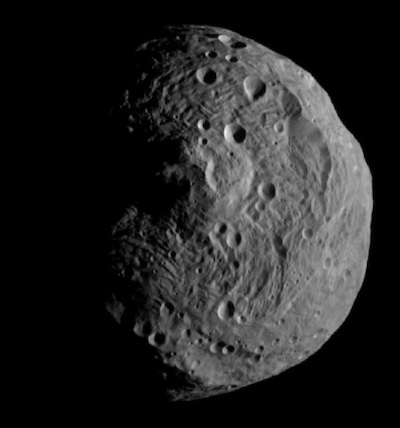
Image credit: NASA
Click to embiggen
End of an Era: How Space Shuttles become museum pieces
It’s official. Space shuttle Atlantis and the crew of STS-135, the final ever space shuttle mission, safely landed back on Earth last Thursday. Now, the future home of the shuttles will be here on Earth, in museums. National Public Radio got a rare look at how a space shuttle becomes a museum piece, including all that is being done to preserve the vehicles for future generations.
Gale Crater announced as target for next Mars rover
After years of debate and study, NASA has finally announced the official landing site chosen for Mars Curiosity, aka Mars Science Laboratory (MSL), the next rover headed to the red planet later this year. The target crater spans 96 miles (154 km) in diameter (about the combined area of Connecticut and Rhode Island) and contains a central mountain that rises higher from the crater floor than Mount Rainier rises above Seattle. “Mars is firmly in our sights,” said NASA Administrator Charles Bolden. “Curiosity not only will return a wealth of important science data, but it will serve as a precursor mission for human exploration to the Red Planet.”
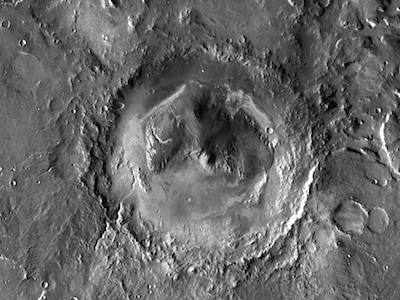
Image credit: NASA
Click to embiggen Gale Crater
Pic of the Week: Hydrothermal worm viewed under an electron microscope
You thought some of the aliens in Star Trek were scary? Check out this microscopic marvel, the hydrothermal worm at 525x zoom! Terrifying. (via HuffPo)
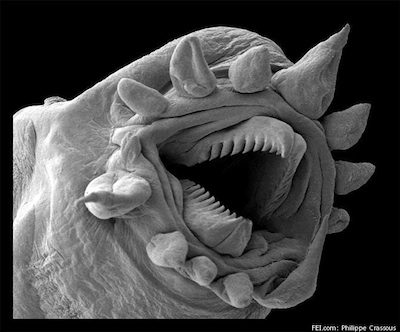
525x zoom on a hydrothermal worm
Gadget of the Week: Geordi’s VISOR is the real deal
New hi-tech bionic glasses, akin to Geordi LaForge’s VISOR, could help those with poor vision to see. Developed at Oxford University, the new glasses use an array of tech such as video cameras, face recognition, position detectors, and tracking software to help those with impaired vision to see objects in front of them. The concept is the same idea behind video games and smart phones, and the glasses will only be able to help those with limited vision to find objects. Perhaps in the future, we will see a VISOR that will restore vision to the blind. More at HuffPo.
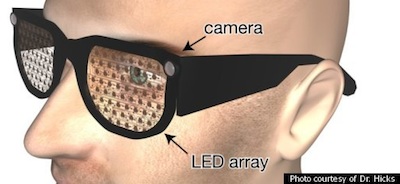
Closer and closer to a real VISOR
Science Bytes
Not enough science for you? Here’s a warp-speed look at some more science tid-bits that are worth a peek.
- Exoplanet aurora: an out-of-this-world sight
- Quasars powered by black hole movements
- 3D printers make anything out of resin or glass

Looks like we’ll be finding out all about dwarf planets simultaneously.
http://uk.reuters.com/article/2011/07/17/us-space-asteroid-idUKTRE76F0KI20110717
With the Dawn probe departing Vesta for Ceres afterwards, on a three year journey across the belt and New Horizons reaching the Pluto system in that amount of time.
3D printer! Yeehaw!!!
It would have been scary if the worm had been discovered on the Pluto moon.
The next probe to Mars should take a batch of Sea Monkey’s with it to kick off the terraforming process.
Awesome 3D printing! They printed a functional crescent wrench with moving parts, no assembly required. AmAzing.
Hmm, I wonder which moon houses the Mass Relay? Haha.
“Bless the maker and his water. Bless his coming and his going. May his passing cleanse the world and may he keep the world for his people.”
That worm is disturbing to say the least.
Kayla you know the guy that archived that THEMIS DAY IR mosaic of Gale crater for the Mars Space Flight Facility ;-)
Great article as always!
That hydrothermal worm looks like those things that attack Lt. Barclay in the transporter in that TNG episode…
@4 Better to take sea monkeys to Mars rather than those hydrothermal worms! Crikey!
Not sure that the Millenium Falcon would’ve survived that worm!
The hydrothermal worm is really small. According to the Huffington Post article, it’s about the size of a bacterium. It also lives in the ocean. near hydrothermal vents.
Let us all hope that the US stores the Space Shuttle in a more reliable place than where the Ruskies decided to place thier Shuttle..
http://www.papermodelers.com/forum/cardboard-lounge/15479-russian-space-shuttle-buran-rebuilt.html
Page down a bit at the above link.
@14. Well, they are supposed to be headed off to aerospace museums across the country. Just a bit better then the Russians stuffing theirs in a run down warehouse…
To me, that worm looks like an even scarier version of the Sandworms from Dune.
The astrophysicist didn’t ask how low or zero gravity would affect the 3D printer. Surely it wouldn’t work properly in space?
I thought the Borg ate pluto?
Please do not describe Pluto as “not a planet” when that represents only one viewpoint in an ongoing debate. Only four percent of the IAU voted on the controversial demotion, and most are not planetary scientists. Hundreds of professional astronomers led by New Horizons Principal Investigator Dr. Alan Stern rejected that decision in a formal petition. Dwarf planets are planets too.
The Dawn and New Horizons missions are going to provide a ton of new data and images. A great investment.
3D Printing…first step toward replicators…
17. John Pearse – July 24, 2011
The astrophysicist didn’t ask how low or zero gravity would affect the 3D printer. Surely it wouldn’t work properly in space?
I noticed that too. From what I can tell, there’s no possible way it could work in a micro-gravity situation. The powder has to remain flat and level for the resin to be sprayed onto it. In a micro-gravity environment, the powder would float and could not remain stationary.